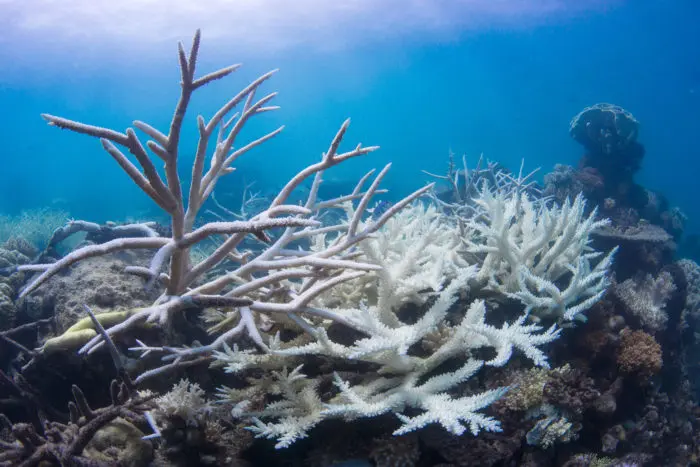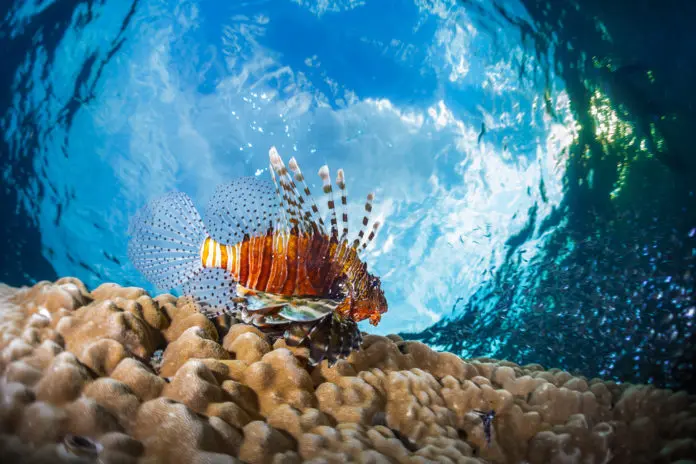It has become increasingly clear that our oceans are in trouble. Water temperatures are rising, Arctic ice is melting. Our oceans and even some of their inhabitants are drowning in plastic. Coral reefs are ‘bleaching’ and species are disappearing. Divers are especially well-placed to both see the results of pollution, to raise the alarm, and to act as ambassadors for the ocean and its creatures. But they cannot do it alone and increasingly science is being used to try and protect the oceans now and in the future. Already technology such as ‘Sea Gliders’, a type of autonomous underwater vehicle, is being used to collect oceanographic data over many months and thousands of miles. Animal telemetry to track and record sea creatures movements has been used for some time. But exciting new developments are currently being trialed and analyzed.
One of the problems scientists are working on involves the unintended introduction of species to habitats where they don’t belong. Lionfish, for example, are an invasive species from the Indo-Pacific area which has colonized areas of the Caribbean and Florida coastline. They are characterized by bright coloration with red, white, creamy, or black bands and spiny fin rays. They have hollow bones in their dorsal fins which they can fill with a toxin to hunt and stun other fish. In humans, a sting can produce pain, nausea, vomiting and sometimes even convulsions but stings are rarely fatal to healthy adults. The real danger from these invaders is that they breed quickly and have few natural predators in their adopted habitat. This leads to their overpopulation of reef areas and drastic reduction of reef diversity. They are considered to be one of the most serious threats to the Caribbean and Florida coral reef ecosystems. Culling by scuba divers is one way to limit their numbers but that is only successful in shallower areas. Lionfish have been reported as deep as 30-150 meters.
But help is at hand. The Worcester Polytechnic Institute is designing a robot to hunt and kill lionfish threatening the coral reefs. It is an ambitious undertaking; the robots need to be able to hunt on their own without human guidance. The idea is that they would be dropped over the side of a boat to work untethered. They also need to be able to distinguish lionfish from other reef inhabitants. Of course, this includes divers! The robot ‘patrolmen’ have a cluster of buoyant spears which are used not only to kill the lionfish but bring them to the surface for collection. Lionfish can be good for eating! Although this robot fisherman is still in the testing stage, it is one of the ingenious methods now being researched to help preserve ocean health and diversity.
Increasingly DNA sequencing, long used in forensics, is giving insights into marine biology. One of the key inhabitants of the oceans is zooplankton, tiny marine animals. These are important food sources for larger fish. They also respond rapidly to environmental change and therefore act as a kind of warning for scientists. Since there are 7,000 described species already, it takes time and a large team of taxonomists to identify them. But with DNA ‘barcoding’ much more can be done quickly. Insights into these tiny organisms are very important for understanding and conserving marine ecosystems.
Another technique being trialed to help the ocean’s inhabitants to deal with changing conditions is CRISPR-cas 9. This gene-editing tool can be used to control which genes get expressed in plants and animals. It has the potential to delete undesirable traits and add desirable ones. So far, CRISPR has been used in experiments to reduce the severity of genetic deafness in mice and to edit bone marrow cells, also in mice, and to treat sickle-cell anemia, also a problem for some human populations. Now it is being used to try and solve one of the marine environments most serious problems: the destruction of coral reef ecosystems.

In the late 1990s, coral reefs experienced their first big wave of what came to be called ‘bleaching’ as the dead corals lost all color. This was due both to rising ocean temperatures and human activities. Some studies estimate that as much as 27% of the global reef ecosystems have been lost to date. Scientists hope that by using CRISPR they can understand what genes are crucial to coral survival. In collaboration with Great Barrier Reef coral experts and the Australian Institute of Marine Science, researchers at UT-Austin and Stanford University School of Medicine are experimenting to learn more about what specific genes in corals do. It is hoped that this knowledge will give scientists a better idea of coral genetics and lifestyles. This will enable biologists to devise ways to help corals deal with the problems facing them. The lead author of the recent study, Phillip Cleves, emphasizes that the idea is not to create a kind of Frankenstein coral but to figure our how corals work and use that information to aid future conservation efforts. The goal is to help corals help themselves. Coral reefs are dying at an alarming rate. They need human input to survive the conditions brought about in part by humans.
Healthy oceans are necessary to the survival of marine creatures, humans and ultimately our wonderful ‘blue planet’ itself. Luckily, all three have science on their side to help solve their increasingly difficult and important problems.

